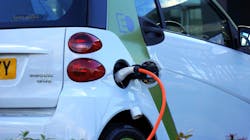When Honda began producing the Insight in the U.S. in 1999, the first commercially available vehicle in the country to offer a hybrid powertrain, it was easy to view the compact two-door car as little more than a fad.
Honda’s Integrated Motor Assist system was the first of its kind to supplement engine power with electric motor assistance, but the funny-looking hybrid ultimately lacked lasting appeal and never developed a loyal following.
Despite the initial lackluster performance of its first hybrid, though, Honda proved to be ahead of its time when it came to electric drivetrains.
Nearly a quarter-century after the Insight made its U.S. debut, hybrids and electric vehicles have finally caught on in the mainstream automotive landscape. Data from Statista shows that the number of EVs and PHEVs in the U.S. has steadily increased since 2015, with both accounting for a combined 1.32 million new vehicle sales in 2021.
Electric drivetrains are quickly saturating the industry, and Barry Dorn, owner of Dorn’s Body and Paint in Mechanicsville, Virginia, says it’s becoming increasingly pertinent to learn more about these vehicles and begin working on them safely and effectively.
“The design and architecture [of EVs and hybrids] are completely different,” Dorn says. “You have to have a completely different mindset when working on them. It’s not the same at all.”
The Wild, Wild West
Though EVs and hybrids are increasingly common, Craig Van Batenburg of the Automotive Career Development Center says rules around who can work on EVs and how to work them are still very far behind.
"It’s the Wild West, the sheriff is drunk, cowboys are in town and nobody cares,” Van Batenburg says. “That’s pretty much how this is regulated.”
Because of that, there aren’t set standards for repair procedures on EVs or hybrids, making automakers the de facto standard bearers for their own vehicles. Many OEMs will require body shops earn a certification before allowing those shops to work on their vehicles. Dorn says this is the first thing shops need to keep in mind before jumping into an EV or hybrid repair.
“They should not be doing a thing to the vehicle until they know if they can work on it. Even the smallest of accidents could compromise an area of the high voltage system,” Dorn says. “There is a lot to consider when you’re working on these vehicles.”
In addition to making sure your shop is capable of working on a vehicle, making sure that it makes sense for your shop is equally important.
“The main thing you’ve got to keep in mind is cost. It’s not just the cost of the tooling, the training and the total amount of equipment,” Dorn says. “Can you take the best group of techs in your shop and be without them for three to six weeks? When they’re gone and in training for weeks at a time, not only are you losing them and paying them and their expenses, you’re also missing their productivity.”
Training is necessary to work on EVs, but it isn’t always the smartest decision for a shop to make if they don’t have the volume to support it. If your shop isn’t equipped, either with the proper tools or the proper training, Dorn says it is significantly easier and safer in the long run to pass on the vehicle.
“We get cars in where someone has started a repair before realizing they couldn’t do it, and that makes it a lot harder on us to start the process and figure out what the scope of repair is,” he says.
Extra Considerations
If your shop decides to take on EV and hybrid repairs, Van Batenburg says there are extra steps that need to be taken.
As most shops know, disabling the high voltage system is required before starting any work on a vehicle. Van Batenburg says that almost all EVs and hybrids have fail-safes that automatically shut down a vehicle’s high voltage system if an airbag is deployed in an accident. The only exception, he says, are model year 2005-2012 Ford Escape hybrids, which feature an inertia switch that shuts off the system in the case of a collision. There are ways that modders and aftermarket techs can disable those systems, but Van Batenburg says that is incredibly difficult to do. Still, it’s best practice to perform a system down procedure with proper personal protective equipment to make sure a vehicle’s system is offline before starting repairs.
Dorn’s shop takes an extra step and scans vehicles with a thermal gun to make sure there are no unusual temperature readings or heat sources coming from a vehicle before beginning work on it.
If there is damage to a lithium-ion battery pack, the vehicle needs to be stored outside 30 feet away from anything. If there isn’t room, call your local fire department—Van Batenburg says they are the go-to resource to figuring out where to store hazardous materials.
In addition to making sure the system is offline, having a plan in place for the worst-case scenario–the battery igniting–is critical to ensuring your team stays safe.
Vehicle fires are rare, and despite public perception, EVs have actually been statistically less likely to catch fire than internal combustion engines–data reported by Auto Insurance EZ shows there were only around 25 fires for every 100,000 EVs sold last year, compared to nearly 1,530 in ICEs for every 100,000. Still, fires can happen, and making sure your team is able to evacuate that vehicle safely and remove it from your shop is critical.
“You need to have an evacuation plan for that car. You’re really at the mercy of that battery,” Dorn says. “Once a fire starts, then it’s virtually impossible to stop it. You need to make sure your staff knows what to do in that situation.”
Even after a vehicle is repaired, there are still extra considerations that have to be taken into account. Van Batenburg says most auto paint manufacturers specify their paint to bake for an hour at 160 degrees Fahrenheit. Nickel batteries cannot be exposed to more than 150 degrees, and lithium shouldn’t be exposed to higher than 140.
Each manufacturer is going to have significantly different standards and systems that it uses for its EVs and hybrid vehicles. Understanding that and how different it is to work on those vehicles, Dorn says, is the single most important thing a shop should do before taking on electric drivetrain work.
“OEMs take working on a battery electric vehicle very seriously because they’re worried about something happening to the high voltage system,” Dorn says. “The big issue that repairers face is not only can they work on a vehicle, but also if they should.”
About the Author

Noah Brown
Noah Brown is a freelance writer and former senior digital editor for 10 Missions Media, where he facilitated multimedia production several of the company's publications.
